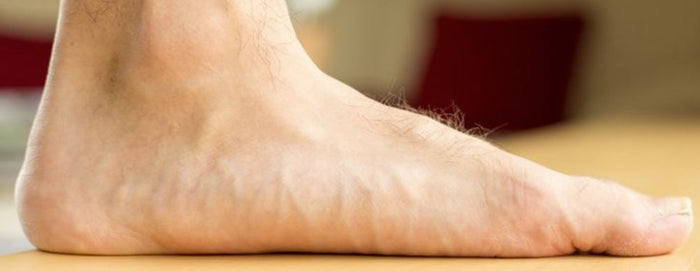HOW TO PREVENT AND TREAT FLAT FEET

Flat feet, also known as fallen arches, is a condition where the arch of the foot collapses, causing the entire sole of the foot to come into contact with the ground (Mayo Clinic). This can lead to pain and discomfort, as well as an increased risk of injury. However, with proper care and preventative measures, it is possible to keep flat feet under control and maintain overall foot health.
One of the most effective ways to prevent and treat flat feet is through the use of orthotics (Medical News Today). Orthotics are inserts that are placed inside the shoes to support the arch of the foot and redistribute weight. They can be prescribed by a podiatrist or orthopedic specialist but also some specialized ones can be attained at retail such as SelectFlex. Orthotics can be made from a variety of materials, including foam, plastic, and leather.
Another important step in preventing and treating flat feet is to wear the right type of shoes. Shoes that offer good arch support and have a sturdy heel are ideal for people with flat feet. Avoiding high heels and shoes with minimal support can also help. People with flat feet may also benefit from shoes that have a rocker sole, which can help reduce the stress on the heel and arch.
Exercise is also important for preventing and treating flat feet (Cleveland Clinic). Strengthening the muscles in the feet and lower legs can help support the arch and reduce the risk of collapse. Simple exercises such as picking up marbles with the toes or rolling a golf ball under the foot can help to improve muscle tone and strength. Stretching exercises for the feet and lower legs can also be beneficial.
Flat feet can also be caused or exacerbated by being overweight or obese. Losing weight through a healthy diet and regular exercise can help to reduce the stress on the feet and lower the risk of developing flat feet.
Regular visits to a podiatrist or orthopedic specialist can also help to prevent and treat flat feet. These professionals can provide a diagnosis, recommend treatment options, and monitor the condition over time.
In some cases, flat feet may require more invasive treatments such as surgery. However, this is usually only recommended as a last resort and only if other treatments have been ineffective.
In summary, flat feet can be a painful and uncomfortable condition, but with proper care and preventative measures, it can be controlled. Wearing orthotics and the right type of shoes, exercising, maintaining a healthy weight, and regular visits to a podiatrist or orthopedic specialist can all help to prevent and treat flat feet.
Consider Wearing SelectFlex Adjustable Orthotics to Help Treat Your Flat Feet.







